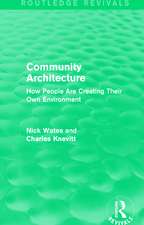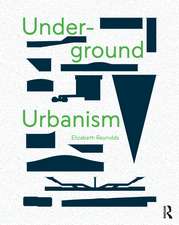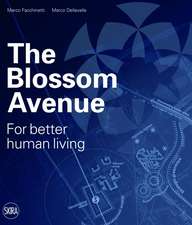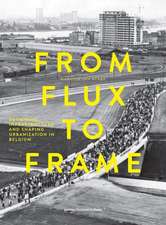The Routledge Handbook of Designing Public Spaces for Young People: Processes, Practices and Policies for Youth Inclusion
Editat de Janet Loebach, Sarah Little, Adina Cox, Patsy Eubanks Owensen Limba Engleză Hardback – 15 iun 2020
The ability of youth to freely enjoy public spaces, and to develop a sense of belonging and attachment to these environments, is critical for their physical, social, cognitive, and emotional development. Young people represent a vital citizen group with legitimate rights to occupy and shape their public environments, yet they are often driven out of public places by adult users, restrictive bylaws, or hostile designs. It is also important that children and youth have the opportunity to genuinely participate in the planning of public spaces, and to have their needs considered in the design of the public realm.
This book provides both evidence and tools to help effectively advocate for more youth-inclusive public environments, as well as integrate youth directly into both research and design processes related to the public realm. It is essential reading for researchers, design and planning professionals, community leaders, and youth advocates.
| Toate formatele și edițiile | Preț | Express |
|---|---|---|
| Paperback (1) | 307.62 lei 43-57 zile | |
| Taylor & Francis – 29 aug 2022 | 307.62 lei 43-57 zile | |
| Hardback (1) | 1563.61 lei 43-57 zile | |
| Taylor & Francis – 15 iun 2020 | 1563.61 lei 43-57 zile |
Preț: 1563.61 lei
Preț vechi: 1906.84 lei
-18% Nou
Puncte Express: 2345
Preț estimativ în valută:
299.29€ • 325.21$ • 251.57£
299.29€ • 325.21$ • 251.57£
Carte tipărită la comandă
Livrare economică 21 aprilie-05 mai
Preluare comenzi: 021 569.72.76
Specificații
ISBN-13: 9781138584921
ISBN-10: 1138584924
Pagini: 448
Ilustrații: 276
Dimensiuni: 178 x 254 x 25 mm
Greutate: 0.99 kg
Ediția:1
Editura: Taylor & Francis
Colecția Routledge
Locul publicării:Oxford, United Kingdom
ISBN-10: 1138584924
Pagini: 448
Ilustrații: 276
Dimensiuni: 178 x 254 x 25 mm
Greutate: 0.99 kg
Ediția:1
Editura: Taylor & Francis
Colecția Routledge
Locul publicării:Oxford, United Kingdom
Public țintă
Postgraduate, Professional, and UndergraduateCuprins
SECTION 1 Introduction — WHY we need to include youth in the creation and use of outdoor public environments.Chapter 1 A Fundamental Need: Linking youth development to the public realm
Chapter 2 Freedom to Flourish: Why independent mobility and access to the public realm is important for youth development
Chapter 3 Risky Play: Why children love it and need it
Chapter 4 Why Is It Important to Provide Child- and Youth- Friendly Streets?
Chapter 5 Experiential accessibly: A therapeutic approach to the design of the public realm
Chapter 6 Engaging Racially and Ethnically Marginalized Youth as Stakeholders of Outdoor Public Environments
Chapter 7 Youth-built Places: Engaging youth in the construction of public places
SECTION 2 Introduction — HOW can we create inclusive, youth-friendly outdoor public environments?
Chapter 8 Welcoming Young People in Urban Placemaking: Learning from challenges
Chapter 9 Turning Young People’s Ideas into Action: Learning from long-term partnerships for child and youth participation
Chapter 10 The Power of Process: Shaping our public domains with young people
Chapter 11 ‘Green Direction’: Illustrating a framework for integrating youth into the design and building of public spaces
Chapter 12 Philadelphia Youth Call for Equitable Development
Chapter 13 Through Engagement to Design: Working with children, young people and communities to improve green spaces in social housing areas
Chapter 14 Fluid Methodology: Investigating a re-imagination of youth friendly public places in the era of rapidly changing technology
Chapter 15 How to Use Big Data for Youth Inclusion: Lessons and insights from video-based social media research on adolescent free play in cities
Chapter 16 ‘Insideness’ as the Lens for Understanding Pre-teens’ Relationship with Place
Chapter 17 How to Integrate Photovoice and Multiple Participatory Methods: Lessons Learned from Collaborating with Tribal Youth in India to Explore their Surrounding Environment
Chapter 18 The Mission: Engaging Aboriginal Australian children in the redesign of community public spaces
Chapter 19 Behavior Mapping to Support the Development of Youth-Friendly Public Places
SECTION 3 Introduction — Youth Inclusion in Practice
Chapter 20 ‘Shaking the Movers’: A rights-respecting youth participation model
Chapter 21 The Great Outdoors Colorado Inspire Initiative – Garfield County, CO
Chapter 22 Friendly for Play?: Engaging young people in examining their neighborhood play environments
Chapter 23 The Rocky Hill Trail: A path of transformation
Chapter 24 In from the Margins: Engaging Latinx youth in Chicago’s Little Village
Chapter 25 From Noisy Coexistence to Inclusion-through-Resistance: (Re)placing youth at London's 'Southbank' skate spot
Chapter 26 Parisite, New Orleans: Some place to play
Chapter 27 Living with Nature, Sheffield, England
Chapter 28 Play Streets to Play Quarters
Chapter 29 Youth Planning + Designing for Play: ‘The Hangout’
Chapter 30 The Manzanita Gathering Place: Engaging marginalized youth in creative place making
Chapter 31 Mindful Mapping: An integrated approach to helping youth navigate neighborhood change
Chapter 2 Freedom to Flourish: Why independent mobility and access to the public realm is important for youth development
Chapter 3 Risky Play: Why children love it and need it
Chapter 4 Why Is It Important to Provide Child- and Youth- Friendly Streets?
Chapter 5 Experiential accessibly: A therapeutic approach to the design of the public realm
Chapter 6 Engaging Racially and Ethnically Marginalized Youth as Stakeholders of Outdoor Public Environments
Chapter 7 Youth-built Places: Engaging youth in the construction of public places
SECTION 2 Introduction — HOW can we create inclusive, youth-friendly outdoor public environments?
Chapter 8 Welcoming Young People in Urban Placemaking: Learning from challenges
Chapter 9 Turning Young People’s Ideas into Action: Learning from long-term partnerships for child and youth participation
Chapter 10 The Power of Process: Shaping our public domains with young people
Chapter 11 ‘Green Direction’: Illustrating a framework for integrating youth into the design and building of public spaces
Chapter 12 Philadelphia Youth Call for Equitable Development
Chapter 13 Through Engagement to Design: Working with children, young people and communities to improve green spaces in social housing areas
Chapter 14 Fluid Methodology: Investigating a re-imagination of youth friendly public places in the era of rapidly changing technology
Chapter 15 How to Use Big Data for Youth Inclusion: Lessons and insights from video-based social media research on adolescent free play in cities
Chapter 16 ‘Insideness’ as the Lens for Understanding Pre-teens’ Relationship with Place
Chapter 17 How to Integrate Photovoice and Multiple Participatory Methods: Lessons Learned from Collaborating with Tribal Youth in India to Explore their Surrounding Environment
Chapter 18 The Mission: Engaging Aboriginal Australian children in the redesign of community public spaces
Chapter 19 Behavior Mapping to Support the Development of Youth-Friendly Public Places
SECTION 3 Introduction — Youth Inclusion in Practice
Chapter 20 ‘Shaking the Movers’: A rights-respecting youth participation model
Chapter 21 The Great Outdoors Colorado Inspire Initiative – Garfield County, CO
Chapter 22 Friendly for Play?: Engaging young people in examining their neighborhood play environments
Chapter 23 The Rocky Hill Trail: A path of transformation
Chapter 24 In from the Margins: Engaging Latinx youth in Chicago’s Little Village
Chapter 25 From Noisy Coexistence to Inclusion-through-Resistance: (Re)placing youth at London's 'Southbank' skate spot
Chapter 26 Parisite, New Orleans: Some place to play
Chapter 27 Living with Nature, Sheffield, England
Chapter 28 Play Streets to Play Quarters
Chapter 29 Youth Planning + Designing for Play: ‘The Hangout’
Chapter 30 The Manzanita Gathering Place: Engaging marginalized youth in creative place making
Chapter 31 Mindful Mapping: An integrated approach to helping youth navigate neighborhood change
Notă biografică
Janet Loebach is an environmental design researcher and consultant hailing from Ontario, Canada. She is currently an Assistant Professor in the Department of Design and Environmental Analysis (http://dea.human.cornell.edu/) at Cornell University. She received a Master of Environmental Design from the School of Architecture and Planning at Dalhousie University, and a PhD in Children’s, Urban, and Health Geographies from the Department of Geography at Western University. She is a registered Professional Civil Engineer (Ontario) and the Principal Consultant for Thrive Design Consulting. Her research and practice focuses on children’s perception and use of their everyday environments, and the socio-environmental factors which influence children’s behavior and well-being. Other areas of expertise include assessment and design of natural and built play and learning environments for children. She also has extensive experience with participatory, child-led and community-based design and planning processes. She currently serves as Vice President of the International Play Association (Canada) and as Co-Chair of the Children, Youth & Environments Network of the Environmental Design Research Association (EDRA).
Sarah Little is a registered landscape architect and an Assistant Professor of Landscape Architecture at the University of Oklahoma. She holds an MLA and a PhD in Design, both from North Carolina State University. Her professional practice primarily consisted of high-end residential landscapes; children’s environments at museums, nature centers, parks, and schools; and park master plans with an emphasis on community participation and environmental justice. After almost 12 years of practicing as a landscape architect, she decided to shift her focus toward research and pursue a PhD. As a researcher, she works to understand the influence of the physical environment on human behavior and development. Her current research interests involve children’s autonomous exploration of the physical environment, accommodating children living with disabilities in the play environment, and Behavior Mapping. As a landscape architect and researcher, she works to disseminate research for fellow design practitioners to facilitate evidence-based design.
Adina Cox is a postdoctoral scholar in the Landscape Architecture Department at the University of Kentucky. She holds a PhD in Design and an MNR in Natural Resources/GIS from North Carolina State University, and a BS in Landscape Architecture from Cal Poly Pomona. Her research interests include youth’s active transportation, children’s outdoor play environments, and the human–nature relationship. She is passionate about social and environmental justice in design. Her work has been inspired by her childhood spent in the redwood forests of northern California, and by her experiences raising her own children in North Carolina.
Patsy Eubanks Owens is a Professor of Landscape Architecture at the University of California, Davis. She holds an MLA from UC Berkeley and a BLA from the University of Georgia. After observing teenagers hanging out on Shattuck Avenue in downtown Berkeley as a graduate student, she sought information on adolescents' place preferences and activities to inform her design decisions. Finding limited research, she focused her thesis and an NEA-funded project on the Venues and Values of Teenagers. More than 30 years later, she continues to examine the role of the physical environment in the development, health, and well-being of youth. She has conducted research with youth in urban, suburban, and rural settings. Her work includes youth-led research and design projects, and topics such as youth exclusion, skateboarding, and the role of nature.
Sarah Little is a registered landscape architect and an Assistant Professor of Landscape Architecture at the University of Oklahoma. She holds an MLA and a PhD in Design, both from North Carolina State University. Her professional practice primarily consisted of high-end residential landscapes; children’s environments at museums, nature centers, parks, and schools; and park master plans with an emphasis on community participation and environmental justice. After almost 12 years of practicing as a landscape architect, she decided to shift her focus toward research and pursue a PhD. As a researcher, she works to understand the influence of the physical environment on human behavior and development. Her current research interests involve children’s autonomous exploration of the physical environment, accommodating children living with disabilities in the play environment, and Behavior Mapping. As a landscape architect and researcher, she works to disseminate research for fellow design practitioners to facilitate evidence-based design.
Adina Cox is a postdoctoral scholar in the Landscape Architecture Department at the University of Kentucky. She holds a PhD in Design and an MNR in Natural Resources/GIS from North Carolina State University, and a BS in Landscape Architecture from Cal Poly Pomona. Her research interests include youth’s active transportation, children’s outdoor play environments, and the human–nature relationship. She is passionate about social and environmental justice in design. Her work has been inspired by her childhood spent in the redwood forests of northern California, and by her experiences raising her own children in North Carolina.
Patsy Eubanks Owens is a Professor of Landscape Architecture at the University of California, Davis. She holds an MLA from UC Berkeley and a BLA from the University of Georgia. After observing teenagers hanging out on Shattuck Avenue in downtown Berkeley as a graduate student, she sought information on adolescents' place preferences and activities to inform her design decisions. Finding limited research, she focused her thesis and an NEA-funded project on the Venues and Values of Teenagers. More than 30 years later, she continues to examine the role of the physical environment in the development, health, and well-being of youth. She has conducted research with youth in urban, suburban, and rural settings. Her work includes youth-led research and design projects, and topics such as youth exclusion, skateboarding, and the role of nature.
Recenzii
"Someday soon we will start to judge the health of a city or neighborhood by the number of kids free to play, roam, and gather outside. When we do, any places that have absorbed the lessons of this book will be ahead of the pack."
Lenore Skenazy
President of Let Grow, and founder of Free-Range Kids
"The public realm has an important role to play in fostering healthy, resilient, and engaged children and youth. Unfortunately, for the last 80 years we have been planning our cities thinking much more about the movement of cars than on the health and happiness of human beings. This kind of planning has been especially harmful to children and youth, severely limiting their right to actively move in and explore the public realm. If we want our parks, streets, and public spaces ringing with the sounds of children’s laughter, high jinks, and play like they used to, then we need to bring to children and youth on as collaborators and co-creators in designing public spaces. The Routledge Handbook of Designing Public Spaces for Young People gives city builders, planners, urban designers, policy makers, and anyone interested in making our cities livable and lovable for children and youth, the important tools and case studies to help get it done. This book comes at an important time as we work to change the course of planning for the public realm, do the work to correct and reconcile the inequities of the past, and create more inclusive and human-centered cities."
Amanda O’Rourke
Executive Director, 8-80 Cities
Toronto, Ontario
880cities.org
"Cities that listen to and engage youth in creating welcoming spaces also tend to promote a high quality of life for all. Drawing from leading scholars and emerging practice, this volume is essential reading for understanding current thinking and best practices for how and why engaging and valuing youth perspectives is so important in the public realm. Exploring fundamental aspects of play, inclusion, and participation in a range of public space projects, this book offers insights and practical suggestions for how youth advocates, policy makers, planners, and urban designers can be leaders and partners with youth in creating more inclusive public spaces in a wide range of urban contexts."
Victoria Derr, Ph.D.
Assistant Professor, Environmental Studies Program, California State University Monterey Bay
Co-author of Placemaking with Children and Youth: Participatory Practices for Planning Sustainable Communities
"Young people have a lot to say…. and we should listen! This book shows how to engage children and youth in planning and design projects in ways that are meaningful, educational… and fun!"
Daniel Iacofano, PhD, FAICP, FASLA
Chief Executive Officer, MIG
Berkeley, California
Co-editor of The Inclusive City: Design Solutions for Buildings, Neighborhoods and Urban Spaces (2007)
Co-author of Streets Reconsidered: Inclusive Design for the Public Realm (Routledge, 2019)
"At a time when growing inequity is threatening our communities and too many public spaces are exclusionary by intent or neglect, this is a welcome and much-needed call—and guide—to action. Loebach, Little, Cox and Eubanks Owens have compiled an impressive and comprehensive collection of research-based knowledge and field-tested practice that makes a compelling case for the importance of public space in the lives of children and youth, and then provides pragmatic guidance and powerful examples for the positive and enduring impact of engaging young people in community-building processes."
David Driskell
Deputy Director, Office of Planning and Community Development, City of Seattle.
Former UNESCO Chair for Growing Up in Cities at Cornell University
Author of Creating Better Cities with Children and Youth: A Manual for Participation
"Jane Jacobs in her 1961 seminal book The Death and Life of Great American Cities states: "Cities have the capability of providing something for everybody, only because, and only when, they are created by everybody." This handbook from editors Loebach, Little, Cox and Eubanks Owens on designing spaces for young people epitomizes these sentiments and brings our attention to the many years of theorising, planning and successful projects that have come before and can be the foundation for interrogation and provocation ahead. Imparting their shared knowledge, the authors, a collective of superstars and influencers in the field of youth and public space, have addressed these questions with a clear intention of igniting sparks, inspiring others, shifting attitudes and exemplifying the range of possibilities for the future. It needs to be on every bookcase and a must read for all academics, advocates and professionals working with young people."
Karen Malone
Professor of Education
Research Director, Department of Education
Faculty of Health, Arts and Design
Swinburne University of Technology, Australia
"The theme of the new Routledge Handbook of Designing Public Spaces for Young People is more topical than ever: why and how the exclusion of children and young people can be turned to inclusion. The various chapters of the book show how young people can be active users, participants, decision makers and even builders of public spaces. The numerous real-life examples of youth participation projects in a variety of contexts present novel, yet tested approaches, that represent both bottom-up, self-initiated participation projects as well as more formal ones. It is finally time to take seriously the potential of young people to become game changers with unique abilities, skills and ideas."
Marketta Kyttä
Professor, Land Use Planning
Aalto University
Helsinki, Finland
Lenore Skenazy
President of Let Grow, and founder of Free-Range Kids
"The public realm has an important role to play in fostering healthy, resilient, and engaged children and youth. Unfortunately, for the last 80 years we have been planning our cities thinking much more about the movement of cars than on the health and happiness of human beings. This kind of planning has been especially harmful to children and youth, severely limiting their right to actively move in and explore the public realm. If we want our parks, streets, and public spaces ringing with the sounds of children’s laughter, high jinks, and play like they used to, then we need to bring to children and youth on as collaborators and co-creators in designing public spaces. The Routledge Handbook of Designing Public Spaces for Young People gives city builders, planners, urban designers, policy makers, and anyone interested in making our cities livable and lovable for children and youth, the important tools and case studies to help get it done. This book comes at an important time as we work to change the course of planning for the public realm, do the work to correct and reconcile the inequities of the past, and create more inclusive and human-centered cities."
Amanda O’Rourke
Executive Director, 8-80 Cities
Toronto, Ontario
880cities.org
"Cities that listen to and engage youth in creating welcoming spaces also tend to promote a high quality of life for all. Drawing from leading scholars and emerging practice, this volume is essential reading for understanding current thinking and best practices for how and why engaging and valuing youth perspectives is so important in the public realm. Exploring fundamental aspects of play, inclusion, and participation in a range of public space projects, this book offers insights and practical suggestions for how youth advocates, policy makers, planners, and urban designers can be leaders and partners with youth in creating more inclusive public spaces in a wide range of urban contexts."
Victoria Derr, Ph.D.
Assistant Professor, Environmental Studies Program, California State University Monterey Bay
Co-author of Placemaking with Children and Youth: Participatory Practices for Planning Sustainable Communities
"Young people have a lot to say…. and we should listen! This book shows how to engage children and youth in planning and design projects in ways that are meaningful, educational… and fun!"
Daniel Iacofano, PhD, FAICP, FASLA
Chief Executive Officer, MIG
Berkeley, California
Co-editor of The Inclusive City: Design Solutions for Buildings, Neighborhoods and Urban Spaces (2007)
Co-author of Streets Reconsidered: Inclusive Design for the Public Realm (Routledge, 2019)
"At a time when growing inequity is threatening our communities and too many public spaces are exclusionary by intent or neglect, this is a welcome and much-needed call—and guide—to action. Loebach, Little, Cox and Eubanks Owens have compiled an impressive and comprehensive collection of research-based knowledge and field-tested practice that makes a compelling case for the importance of public space in the lives of children and youth, and then provides pragmatic guidance and powerful examples for the positive and enduring impact of engaging young people in community-building processes."
David Driskell
Deputy Director, Office of Planning and Community Development, City of Seattle.
Former UNESCO Chair for Growing Up in Cities at Cornell University
Author of Creating Better Cities with Children and Youth: A Manual for Participation
"Jane Jacobs in her 1961 seminal book The Death and Life of Great American Cities states: "Cities have the capability of providing something for everybody, only because, and only when, they are created by everybody." This handbook from editors Loebach, Little, Cox and Eubanks Owens on designing spaces for young people epitomizes these sentiments and brings our attention to the many years of theorising, planning and successful projects that have come before and can be the foundation for interrogation and provocation ahead. Imparting their shared knowledge, the authors, a collective of superstars and influencers in the field of youth and public space, have addressed these questions with a clear intention of igniting sparks, inspiring others, shifting attitudes and exemplifying the range of possibilities for the future. It needs to be on every bookcase and a must read for all academics, advocates and professionals working with young people."
Karen Malone
Professor of Education
Research Director, Department of Education
Faculty of Health, Arts and Design
Swinburne University of Technology, Australia
"The theme of the new Routledge Handbook of Designing Public Spaces for Young People is more topical than ever: why and how the exclusion of children and young people can be turned to inclusion. The various chapters of the book show how young people can be active users, participants, decision makers and even builders of public spaces. The numerous real-life examples of youth participation projects in a variety of contexts present novel, yet tested approaches, that represent both bottom-up, self-initiated participation projects as well as more formal ones. It is finally time to take seriously the potential of young people to become game changers with unique abilities, skills and ideas."
Marketta Kyttä
Professor, Land Use Planning
Aalto University
Helsinki, Finland
Descriere
This handbook provides up to date research and case studies that highlight both the need and strategies for creating inclusive, youth‐friendly public outdoor environments around the world.















